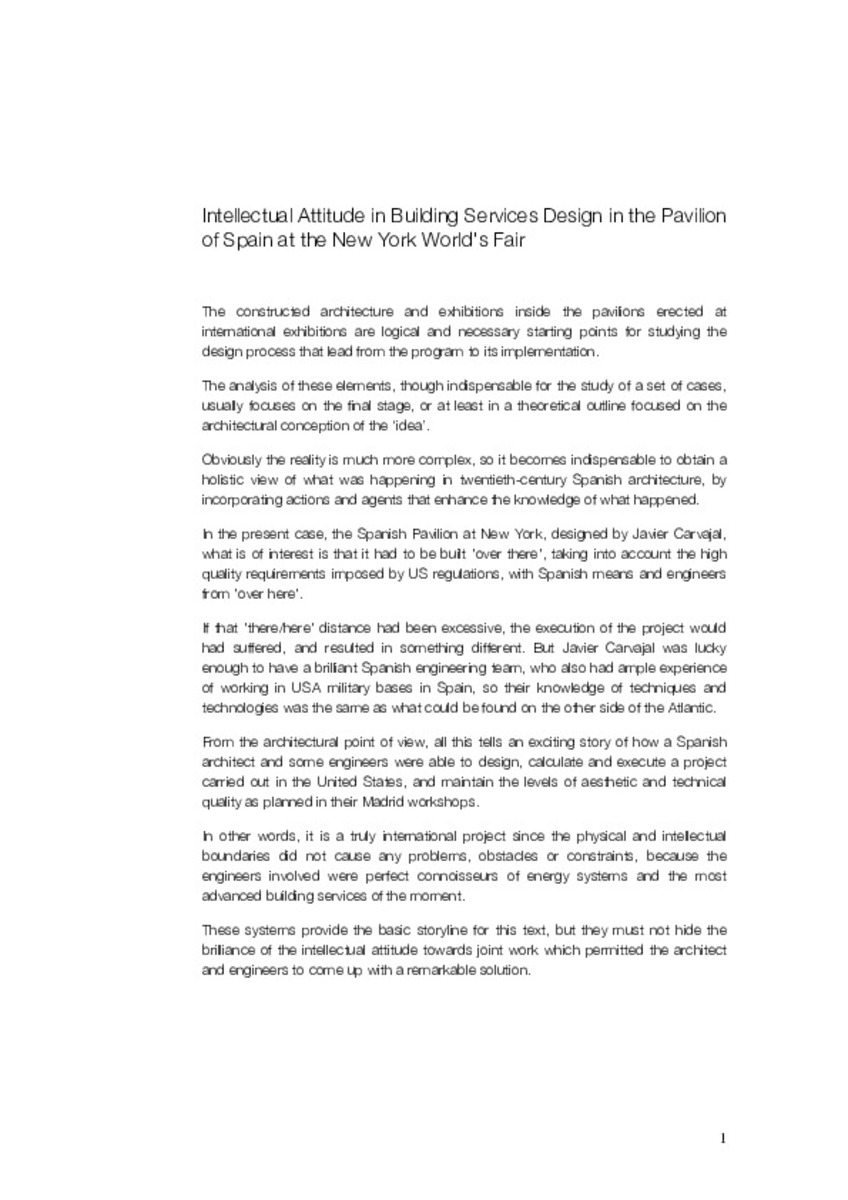Full metadata record
| DC Field | Value | Language |
|---|---|---|
| dc.creator | Martín-Gómez, C. (César) | - |
| dc.creator | Barrutia, B. (Borja) | - |
| dc.date.accessioned | 2014-06-24T10:49:37Z | - |
| dc.date.available | 2014-06-24T10:49:37Z | - |
| dc.date.issued | 2014 | - |
| dc.identifier.citation | Martín-Gómez, C., Barrutia, C, ""Intellectual Attitude in Building Services Design in the Pavilion of Spain at the New York World’s Fair"". En: Pozo, J.M., García-Diego Villarías, H, Caballero, B. (coords.) "" Las exposiciones de arquitectura y la arquitectura de las exposicionesLas arquitectura española y las exposiciones internacionales (1929-1975). Actas preliminares"" Ed. T6, pp.437-446 | es_ES |
| dc.identifier.isbn | 978-84-92409-61-7 | - |
| dc.identifier.uri | https://hdl.handle.net/10171/36098 | - |
| dc.description.abstract | The constructed architecture and exhibitions inside the pavilions erected at international exhibitions are logical and necessary starting points for studying the design process that lead from the program to its implementation. The analysis of these elements, though indispensable for the study of a set of cases, usually focuses on the final stage, or at least in a theoretical outline focused on the architectural conception of the ‘idea’. Obviously the reality is much more complex, so it becomes indispensable to obtain a holistic view of what was happening in twentieth-century Spanish architecture, by incorporating actions and agents that enhance the knowledge of what happened. In the present case, the Spanish Pavilion at New York, designed by Javier Carvajal, what is of interest is that it had to be built 'over there', taking into account the high quality requirements imposed by US regulations, with Spanish means and engineers from 'over here'. If that 'there/here' distance had been excessive, the execution of the project would had suffered, and resulted in something different. But Javier Carvajal was lucky enough to have a brilliant Spanish engineering team, who also had ample experience of working in USA military bases in Spain, so their knowledge of techniques and technologies was the same as what could be found on the other side of the Atlantic. From the architectural point of view, all this tells an exciting story of how a Spanish architect and some engineers were able to design, calculate and execute a project carried out in the United States, and maintain the levels of aesthetic and technical quality as planned in their Madrid workshops. In other words, it is a truly international project since the physical and intellectual boundaries did not cause any problems, obstacles or constraints, because the engineers involved were perfect connoisseurs of energy systems and the most advanced building services of the moment. These systems provide the basic storyline for this text, but they must not hide the brilliance of the intellectual attitude towards joint work which permitted the architect and engineers to come up with a remarkable solution. | es_ES |
| dc.language.iso | eng | es_ES |
| dc.publisher | T6 Ediciones | es_ES |
| dc.rights | info:eu-repo/semantics/openAccess | es_ES |
| dc.subject | Arquitectura | es_ES |
| dc.subject | Instalaciones | es_ES |
| dc.subject | Diseño | es_ES |
| dc.subject | New York | es_ES |
| dc.subject | Pabellón | es_ES |
| dc.subject | Carvajal | es_ES |
| dc.title | Intellectual Attitude in Building Services Design in the Pavilion of Spain at the New York World’s Fair | es_ES |
| dc.type | info:eu-repo/semantics/bookPart | es_ES |
Files in This Item:
Statistics and impact
Items in Dadun are protected by copyright, with all rights reserved, unless otherwise indicated.






